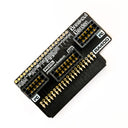Breakout Garden for Raspberry Pi 400 & 500
by Pimoroni





Now at right angles! An easy, solderless, swappable way to use breakouts with your Raspberry Pi 400 or 500 - just pop up to three Breakout Garden breakouts (2 x I2C, 1 x SPI) into the slots and get coding and creating!
Breakout Garden 400 plugs into your Pi's GPIO pins and lets you connect up to three Breakout Garden breakouts so they're conveniently forward facing and the right way up. We've got environmental sensors so you can keep track of the temperature and humidity in your office, a whole host of little screens for important notifications, readouts and GIFs, and, of course, LEDs (the Pi 400 is great, but needs more LEDs, amirite?). We've got a ton more too - check out the complete list of breakouts here!
The three sturdy black slots are edge connectors that connect the breakouts to the pins on your Raspberry Pi. There's one slot for SPI breakouts (like our 0.96" LCD Breakout or 1.12" SPI OLED Breakout), and two for I2C breakouts. Because I2C is a bus, you can use multiple I2C devices at the same time, providing they don't have the same I2C address (we've made sure that all our varieties of breakout have different addresses, and we print them on the back of the breakouts so they're easy to find).
As well as being a handy way to add functionality to your Pi 400, Breakout Garden is also very useful for prototyping projects without the need for complicated wiring, soldering, or breadboards, and you can grow or change up your setup at any time.
Please note that breakouts are sold separately!
Features
- Three sturdy edge-connector slots for Breakout Garden breakouts
- 2x I2C slots (5 pins)
- 1x SPI slot (7 pins)
- 0.1” pitch, 5 or 7 pin connectors
- Broken-out pins
- Reverse polarity protection (built into breakouts)
- Exclusive right angle format for the Raspberry Pi 400 and Raspberry Pi 500
Using Breakout Garden
Because of the way that I2C (the protocol that Breakout Garden uses) works, it doesn't matter which slot on the Breakout Garden that you plug your breakout into. Each I2C device has an address (you'll see it on the back of each breakout) that it uses to identify itself to other I2C devices, so it's effectively saying to your Raspberry Pi, "Hey, it's me, Bob!"
SPI is a faster, higher-throughput protocol for talking to devices like displays. The SPI slot on Breakout Garden Mini uses chip select 1 (BCM 7) and BCM 19 for the GPIO pin (used for things like LCD backlights).
We've built reverse polarity protection into our Breakout Garden breakouts, meaning that there's no magic blue smoke if you accidentally plug one in the wrong way round. However, the correct way to plug them in is to make sure that the labels on the pins on your breakout and the labels on each Breakout Garden 400 slot match up.
We've also broken out a load of useful pins along the top, so you can connect other devices and integrate them into your Breakout Garden projects. If you have breakouts to which you've already soldered headers, then you can use this top row of pins to use them alongside other breakouts on Breakout Garden Mini.
Software
Check out the shop pages for whatever breakouts you're using - they will link you to the Python library and installation instructions.
Notes
- Note that if you're planning on using this Breakout Garden with a Pi 500 it will obstruct one of the HDMI connectors.
-
Breakout Garden for Raspberry Pi 400 & 500
PIM532£9.00
Shop with confidence – we've been serving the hobbyist electronics, Maker, and retro gaming communities since 2012.
- Satisfaction or refund guarantee
- Worldwide shipping via mail or courier
- 57,000+ customer reviews
- Secure website and payments
